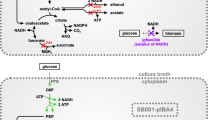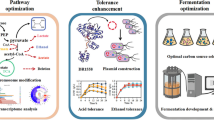Abstract
A metabolically engineered Escherichia coli has been constructed for the production of meso-2,3-butanediol (2,3-BD) under low oxygen condition. Genes responsible for 2,3-BD formation from pyruvate were assembled together to generate a high-copy plasmid pEnBD, in which each gene was transcribed with a constitutive promoter. To eliminate by-product formation under low oxygen condition, genes including ldhA, pta, adhE, and poxB which functioned for the mixed acid fermentation pathways were deleted in E. coli JM109. Compared with the wild type, the quadruple gene deletion mutant produced smaller amounts of acetate, succinate, and ethanol from glucose when cultivated in LB medium in shake flasks under low-aeration. When 2,3-BD producing pathway was introduced via pEnBD into the mutant, higher glucose consumption and faster 2,3-BD production rate compared with that of the wild-type control were observed under aerobic condition in shake flasks. In a 6-L fermentor supplied with only 3% dissolved oxygen (DO), the mutant harboring pEnBD converted glucose to 2,3-BD much faster than the control did. When DO supply was further lowered to 1% DO, the recombinant mutant grew much slower but produced 2,3-BD as a major fermentation metabolic product. In addition, the 2,3-BD yield showed an increase from 0.20 g BD/g glucose for the control to 0.43 g BD/g glucose for the mixed acid pathway deleted mutant grown in fermentors under 1% DO. These results reveals the potential of production of enantiomerically pure 2,3-BD isomer by recombinant E. coli under low oxygen condition.



Similar content being viewed by others
References
Bartowsky EJ, Henschke PA (2004) The ‘buttery’ attribute of wine-diacetyl-desirability, spoilage and beyond. Int J Food Microbiol 96:235–252
Beronio PB, Tsao GT (1993) Optimization of 2, 3-butanediol production by Klebsiella oxytoca through oxygen transfer rate control. Biotechnol Bioeng 42:1263–1269
Celińska E, Grajek W (2009) Biotechnological production of 2, 3-butanediol-current state and prospects. Biotechnol Adv 27:715–725
Converti A, Perego P, Del Borghi M (2003) Effect of specific oxygen uptake rate on Enterobacter aerogenes energetics: carbon and reduction degree balances in batch cultivations. Biotechnol Bioeng 82:370–377
Datsenko KA, Wanner BL (2000) One-step inactivation of chromosomal genes in Escherichia coli K-12 using PCR products. Proc Natl Acad Sci U S A 97:6640–6645
Hespell RB (1996) Fermentation of xylan, corn fiber, or sugars to acetoin and butanediol by Bacillus polymyxa strains. Curr Microbiol 32:291–296
Ji XJ, Huang H, Li S, Du J, Lian M (2008) Enhanced 2, 3-butanediol production by altering the mixed acid fermentation pathway in Klebsiella oxytoca. Biotechnol Lett 30:731–734
Ji XJ, Huang H, Du J, Zhu JG, Ren LJ, Hu N, Li S (2009a) Enhanced 2, 3-butanediol production by Klebsiella oxytoca using a two-stage agitation speed control strategy. Bioresour Technol 100:3410–3414
Ji XJ, Huang H, Du J, Zhu JG, Ren LJ, Li S, Nie ZK (2009b) Development of an industrial medium for economical 2, 3-butanediol production through co-fermentation of glucose and xylose by Klebsiella oxytoca. Bioresour Technol 100:5214–5218
Ji XJ, Huang H, Zhu JG, Ren LJ, Nie ZK, Du J, Li S (2010) Engineering Klebsiella oxytoca for efficient 2, 3-butanediol production through insertional inactivation of acetaldehyde dehydrogenase gene. Appl Microbiol Biotechnol 85:1751–1758
Kabir MM, Ho PY, Shimizu K (2005) Effect of ldhA gene deletion on the metabolism of Escherichia coli based on gene expression, enzyme activities, intracellular metabolite concentrations, and metabolic flux distribution. Biochem Eng J 26:1–11
Li M, Yao SJ, Shimizu K (2007) Effect of poxB gene knockout on metabolism in Escherichia coli based on growth characteristics and enzyme activities. World J Microbiol Biotechnol 23:573–580
Li ZJ, Shi ZY, Jian J, Guo YY, Wu Q, Chen GQ (2010) Production of poly(3-hydroxybutyrate-co-4-hydroxybutyrate) from unrelated carbon sources by metabolically engineered Escherichia coli. Metab Eng. doi:10.1016/j.ymben.2010.03.003
Ma CQ, Wang AL, Qin JY, Li LX, Ai XL, Jiang TY, Tang HZ, Xu P (2009) Enhanced 2, 3-butanediol production by Klebsiella pneumoniae SDM. Appl Microbiol Biotechnol 82:49–57
Nakashimada Y, Kanai K, Nishio N (1998) Optimization of dilution rate, pH and oxygen supply on optical purity of 2, 3-butanediol produced by Paenibacillus polymyxa in chemostat culture. Biotechnol Lett 20:1133–1138
Ramos HC, Hoffmann T, Marino M, Nedjari H, Presecan-Siedel E, Dreesen O, Glaser P, Jahn D (2000) Fermentative metabolism of Bacillus subtilis: physiology and regulation of gene expression. J Bacteriol 182:3072–3080
Renna MC, Najimudin N, Winik LR, Zahler SA (1993) Regulation of the Bacillus subtilis alsS, alsD, and alsR genes involved in post-exponential-phase production of acetoin. J Bacteriol 175:3863–3875
Syu MJ (2001) Biological production of 2, 3-butanediol. Appl Microbiol Biotechnol 55:10–18
Ui S, Okajima Y, Mimura A, Kanai H, Kobayashi T, Kudo T (1997a) Sequence analysis of the gene for and characterization of d-acetoin forming meso-2, 3-butanediol dehydrogenase of Klebsiella pneumoniae expressed in Escherichia coli. J Ferment Bioeng 83:32–37
Ui S, Okajima Y, Mimura A, Kanai H, Kudo T (1997b) Molecular generation of an Escherichia coli strain producing only the meso-isomer of 2, 3-butanediol. J Ferment Bioeng 84:185–189
Ui S, Takusagawa Y, Sato T, Ohtsuki T, Mimura A, Ohkuma M, Kudo T (2004) Production of L-2, 3-butanediol by a new pathway constructed in Escherichia coli. Lett Appl Microbiol 39:533–537
Wardwell SA, Yang YT, Chang HY, San KY, Rudolph FB, Bennett GN (2001) Expression of the Klebsiella pneumoniae CG21 acetoin reductase gene in Clostridium acetobutylicum ATCC 824. J Ind Microbiol Biotechnol 27:220–227
Yan YJ, Lee CC, Liao JC (2009) Enantioselective synthesis of pure (R, R)-2, 3-butanediol in Escherichia coli with stereospecific secondary alcohol dehydrogenases. Org Biomol Chem 7:3914–3917
Zeng AP, Biebl H, Deckwer WD (1990) 2, 3-Butanediol production by Enterobacter aerogenes in continuous culture: role of oxygen supply. Appl Microbiol Biotechnol 33:264–268
Acknowledgements
We are grateful to Professor De-Hua Liu of Tsinghua University for the generous donation of Kebsiella pneumonia 14sp-N. We also thank E. coli Genetic Stock Center at Yale University for the kind donation of plasmids pKD46, pKD13, and pCP20. This research was financially supported by China National High Tech 863 Grant (Project No. 20071860338), the State Basic Science Foundation 973 (2007CB707804), and China National Key Technology R&D Program (Project No. 20091851262).
Author information
Authors and Affiliations
Corresponding author
Rights and permissions
About this article
Cite this article
Li, ZJ., Jian, J., Wei, XX. et al. Microbial production of meso-2,3-butanediol by metabolically engineered Escherichia coli under low oxygen condition. Appl Microbiol Biotechnol 87, 2001–2009 (2010). https://doi.org/10.1007/s00253-010-2676-2
Received:
Revised:
Accepted:
Published:
Issue Date:
DOI: https://doi.org/10.1007/s00253-010-2676-2




